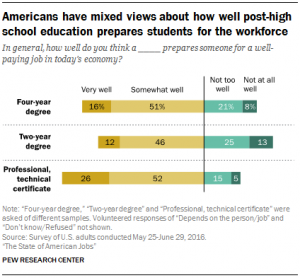
Andy Van Kleunen, Executive Director of the National Skills Coalition
Andy Van Kleunen is Executive Director of the National Skills Coalition, which he founded in 1998 as The Workforce Alliance in collaboration with leaders from the workforce development and philanthropic communities. Van Kleunen has led the NSC to become a nationally-recognized voice on behalf of a diverse array of stakeholders, building upon his experience as a community organizer, a policy analyst, and a practitioner-advocate with roots in the workforce field. He oversees all aspects of the NSC’s efforts, including building alliances with new partners as well as advising state and federal policy initiatives.
There has been another surge in press about whether a “skills gap†really exists in today’s lagging economy.  This most recent bump comes courtesy of disappointing May and June job numbers and the coincident release of a new book by University of Pennsylvania economist Peter Capelli which Time Magazine covered in an article entitled, “The Skills Gap Myth.â€
Let’s acknowledge up front that this is a worthy debate to have, and that there are valid arguments on both sides. But if you’re running a Career and Technical Education (CTE) program with a waiting list of students trying to get in and a group of employers at the other end anxious to hire your graduates, this debate about a skills gap may seem a bit surreal. For you, it’s not a question of whether recovering industries like manufacturing or healthcare are ready to hire; it’s a question of whether our CTE programs have enough capacity to meet that demand. We know there is a skills gap and we know that CTE programs can help fill it.
But skeptical journalists—including those who care enough to read economists like Capelli—have a hard time believing there isn’t something else at play when you have millions of people out of work and 3.5 million jobs going unfilled. Employers may say they can’t find workers with the right skills, but that seems to fly in the face of the immutable powers of the market, where labor supply and demand automatically match up once there’s been a necessary adjustment in price (i.e., wages) to attract more candidates. If employers want welders, pay enough and they will come.

Of course, this assumes there are qualified welders (or CNC machinists, or nurses, or ACE-certified auto mechanics, or rad-techs) sitting on the sidelines of the labor market, fully credentialed but not working because they’re waiting for a better offer. The fact you would be hard pressed to find an unemployed welder isn’t acknowledged by these models; employers are snatching them up as quickly as they can find them.  Nor do they acknowledge that there are many unemployed workers who would be happy to command a welder’s starting wage, but that there aren’t enough funded CTE program slots out there to train all of them.
Capelli would add that, in addition to being stingy, employers are being overly selective. During my recent appearance on a radio show, the host claimed employers aren’t satisfied unless applicants have the “whole package,†the job market equivalent of baseball’s five-tool player: literacy and numeracy, technical competencies, communications skills, the ability to work in teams, prior experience in the field.
Employers are no doubt being more cautious in their hiring right now, for a variety of reasons (some better than others). But it’s hard to ignore that some industries have changed substantially over the past decade, requiring candidates with broader skills than may have been expected for the same position 10 years ago. So is this an argument against further investments in workforce skills? Instead, shouldn’t we be thinking about expanding opportunities for people to enroll in the kind of industry-informed, applied education and training that our best CTE programs are providing for their students in the classroom, through internships and even through on-the-job training? Such programs aren’t cheap, but we know they can be effective. Just ask the employers who hire from them.
So bring on the debate about the skills gap. But let’s make sure we include the experiences of the CTE community and their partners in the discussion.
How Can You Get Involved?
The Friends of CTE Guest Blog Series provides advocates – from business and industry, to researchers and organizations – an opportunity to articulate their support for Career Technical Education. The monthly series features a guest blogger who provides their perspective on and experience with CTE as it relates to policy, the economy and education.
Are you interested in being a guest blogger and expressing your support for CTE? Contact Erin Uy, Communications and Marketing Manager, at euy@careertech.org.



 Contributing to a growing body of research on the economic benefit of industry credentials, the Public Policy Institute of California last month released a
Contributing to a growing body of research on the economic benefit of industry credentials, the Public Policy Institute of California last month released a 


